Estimating Cost Advice for Scheme A and B | Desklib
VerifiedAdded on 2022/11/17
|10
|3829
|272
AI Summary
This document provides cost advice for Scheme A and B, along with their advantages and disadvantages. It also discusses the effect of different design decisions on the cost of building. The document is suitable for students studying construction and engineering courses.
Contribute Materials
Your contribution can guide someone’s learning journey. Share your
documents today.

300726 Estimating 2
[Name]
[Course]
[Prof. concerned]
[Date]
[Name]
[Course]
[Prof. concerned]
[Date]
Secure Best Marks with AI Grader
Need help grading? Try our AI Grader for instant feedback on your assignments.
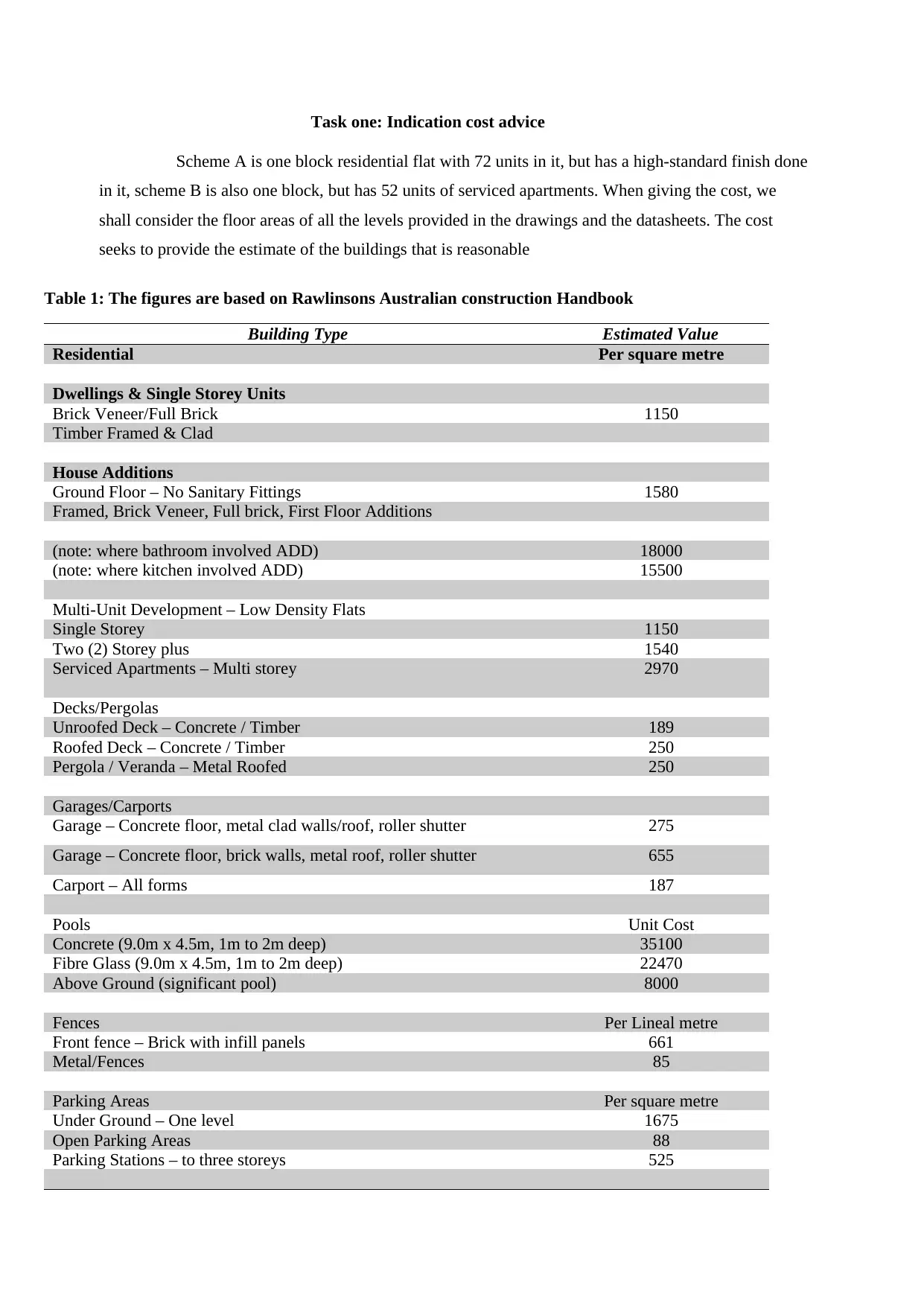
Task one: Indication cost advice
Scheme A is one block residential flat with 72 units in it, but has a high-standard finish done
in it, scheme B is also one block, but has 52 units of serviced apartments. When giving the cost, we
shall consider the floor areas of all the levels provided in the drawings and the datasheets. The cost
seeks to provide the estimate of the buildings that is reasonable
Table 1: The figures are based on Rawlinsons Australian construction Handbook
Building Type Estimated Value
Residential Per square metre
Dwellings & Single Storey Units
Brick Veneer/Full Brick 1150
Timber Framed & Clad
House Additions
Ground Floor – No Sanitary Fittings 1580
Framed, Brick Veneer, Full brick, First Floor Additions
(note: where bathroom involved ADD) 18000
(note: where kitchen involved ADD) 15500
Multi-Unit Development – Low Density Flats
Single Storey 1150
Two (2) Storey plus 1540
Serviced Apartments – Multi storey 2970
Decks/Pergolas
Unroofed Deck – Concrete / Timber 189
Roofed Deck – Concrete / Timber 250
Pergola / Veranda – Metal Roofed 250
Garages/Carports
Garage – Concrete floor, metal clad walls/roof, roller shutter 275
Garage – Concrete floor, brick walls, metal roof, roller shutter 655
Carport – All forms 187
Pools Unit Cost
Concrete (9.0m x 4.5m, 1m to 2m deep) 35100
Fibre Glass (9.0m x 4.5m, 1m to 2m deep) 22470
Above Ground (significant pool) 8000
Fences Per Lineal metre
Front fence – Brick with infill panels 661
Metal/Fences 85
Parking Areas Per square metre
Under Ground – One level 1675
Open Parking Areas 88
Parking Stations – to three storeys 525
Scheme A is one block residential flat with 72 units in it, but has a high-standard finish done
in it, scheme B is also one block, but has 52 units of serviced apartments. When giving the cost, we
shall consider the floor areas of all the levels provided in the drawings and the datasheets. The cost
seeks to provide the estimate of the buildings that is reasonable
Table 1: The figures are based on Rawlinsons Australian construction Handbook
Building Type Estimated Value
Residential Per square metre
Dwellings & Single Storey Units
Brick Veneer/Full Brick 1150
Timber Framed & Clad
House Additions
Ground Floor – No Sanitary Fittings 1580
Framed, Brick Veneer, Full brick, First Floor Additions
(note: where bathroom involved ADD) 18000
(note: where kitchen involved ADD) 15500
Multi-Unit Development – Low Density Flats
Single Storey 1150
Two (2) Storey plus 1540
Serviced Apartments – Multi storey 2970
Decks/Pergolas
Unroofed Deck – Concrete / Timber 189
Roofed Deck – Concrete / Timber 250
Pergola / Veranda – Metal Roofed 250
Garages/Carports
Garage – Concrete floor, metal clad walls/roof, roller shutter 275
Garage – Concrete floor, brick walls, metal roof, roller shutter 655
Carport – All forms 187
Pools Unit Cost
Concrete (9.0m x 4.5m, 1m to 2m deep) 35100
Fibre Glass (9.0m x 4.5m, 1m to 2m deep) 22470
Above Ground (significant pool) 8000
Fences Per Lineal metre
Front fence – Brick with infill panels 661
Metal/Fences 85
Parking Areas Per square metre
Under Ground – One level 1675
Open Parking Areas 88
Parking Stations – to three storeys 525
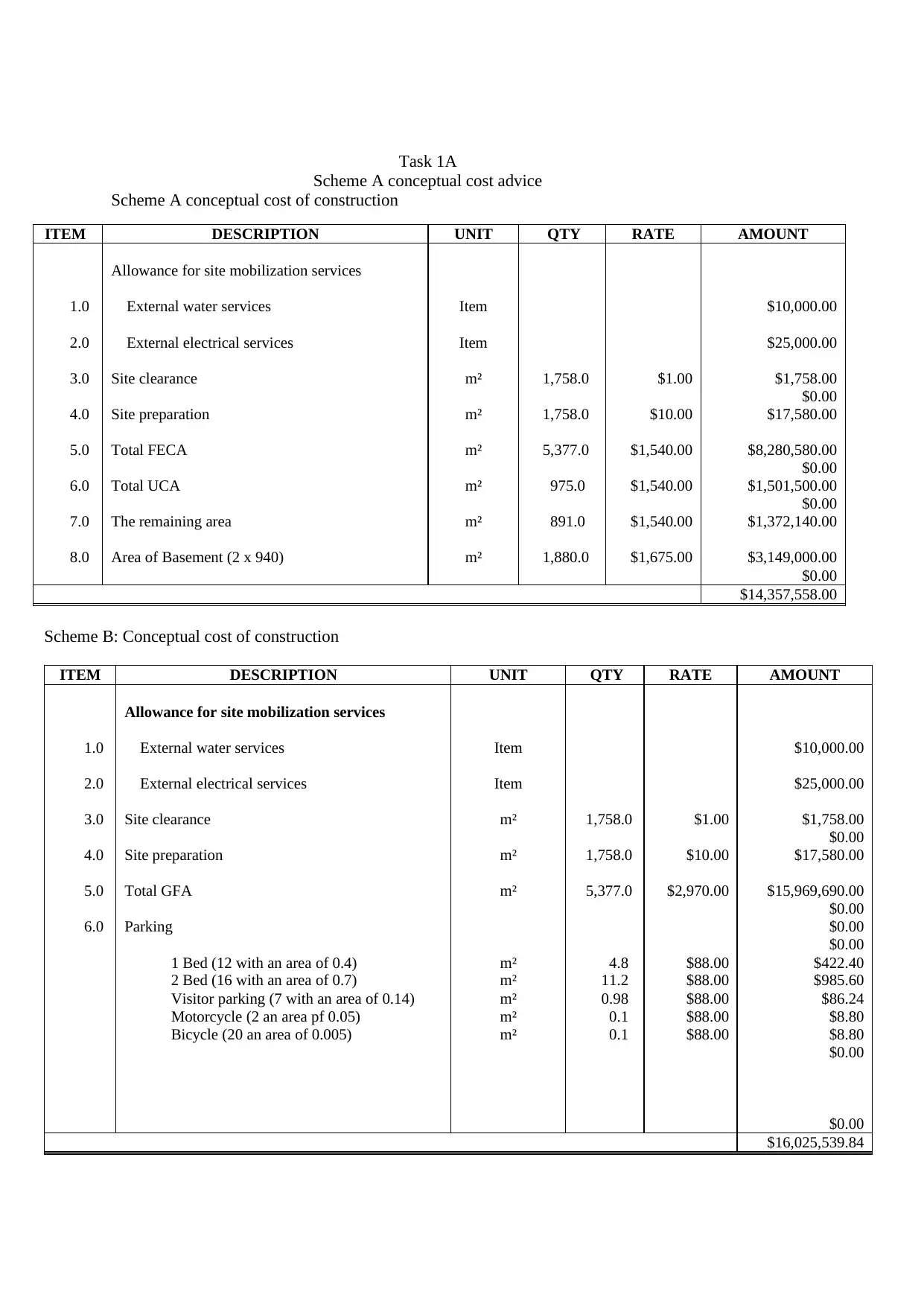
Task 1A
Scheme A conceptual cost advice
Scheme A conceptual cost of construction
ITEM DESCRIPTION UNIT QTY RATE AMOUNT
Allowance for site mobilization services
1.0 External water services Item $10,000.00
2.0 External electrical services Item $25,000.00
3.0 Site clearance m² 1,758.0 $1.00 $1,758.00
$0.00
4.0 Site preparation m² 1,758.0 $10.00 $17,580.00
5.0 Total FECA m² 5,377.0 $1,540.00 $8,280,580.00
$0.00
6.0 Total UCA m² 975.0 $1,540.00 $1,501,500.00
$0.00
7.0 The remaining area m² 891.0 $1,540.00 $1,372,140.00
8.0 Area of Basement (2 x 940) m² 1,880.0 $1,675.00 $3,149,000.00
$0.00
$14,357,558.00
Scheme B: Conceptual cost of construction
ITEM DESCRIPTION UNIT QTY RATE AMOUNT
Allowance for site mobilization services
1.0 External water services Item $10,000.00
2.0 External electrical services Item $25,000.00
3.0 Site clearance m² 1,758.0 $1.00 $1,758.00
$0.00
4.0 Site preparation m² 1,758.0 $10.00 $17,580.00
5.0 Total GFA m² 5,377.0 $2,970.00 $15,969,690.00
$0.00
6.0 Parking $0.00
$0.00
1 Bed (12 with an area of 0.4) m² 4.8 $88.00 $422.40
2 Bed (16 with an area of 0.7) m² 11.2 $88.00 $985.60
Visitor parking (7 with an area of 0.14) m² 0.98 $88.00 $86.24
Motorcycle (2 an area pf 0.05) m² 0.1 $88.00 $8.80
Bicycle (20 an area of 0.005) m² 0.1 $88.00 $8.80
$0.00
$0.00
$16,025,539.84
Scheme A conceptual cost advice
Scheme A conceptual cost of construction
ITEM DESCRIPTION UNIT QTY RATE AMOUNT
Allowance for site mobilization services
1.0 External water services Item $10,000.00
2.0 External electrical services Item $25,000.00
3.0 Site clearance m² 1,758.0 $1.00 $1,758.00
$0.00
4.0 Site preparation m² 1,758.0 $10.00 $17,580.00
5.0 Total FECA m² 5,377.0 $1,540.00 $8,280,580.00
$0.00
6.0 Total UCA m² 975.0 $1,540.00 $1,501,500.00
$0.00
7.0 The remaining area m² 891.0 $1,540.00 $1,372,140.00
8.0 Area of Basement (2 x 940) m² 1,880.0 $1,675.00 $3,149,000.00
$0.00
$14,357,558.00
Scheme B: Conceptual cost of construction
ITEM DESCRIPTION UNIT QTY RATE AMOUNT
Allowance for site mobilization services
1.0 External water services Item $10,000.00
2.0 External electrical services Item $25,000.00
3.0 Site clearance m² 1,758.0 $1.00 $1,758.00
$0.00
4.0 Site preparation m² 1,758.0 $10.00 $17,580.00
5.0 Total GFA m² 5,377.0 $2,970.00 $15,969,690.00
$0.00
6.0 Parking $0.00
$0.00
1 Bed (12 with an area of 0.4) m² 4.8 $88.00 $422.40
2 Bed (16 with an area of 0.7) m² 11.2 $88.00 $985.60
Visitor parking (7 with an area of 0.14) m² 0.98 $88.00 $86.24
Motorcycle (2 an area pf 0.05) m² 0.1 $88.00 $8.80
Bicycle (20 an area of 0.005) m² 0.1 $88.00 $8.80
$0.00
$0.00
$16,025,539.84
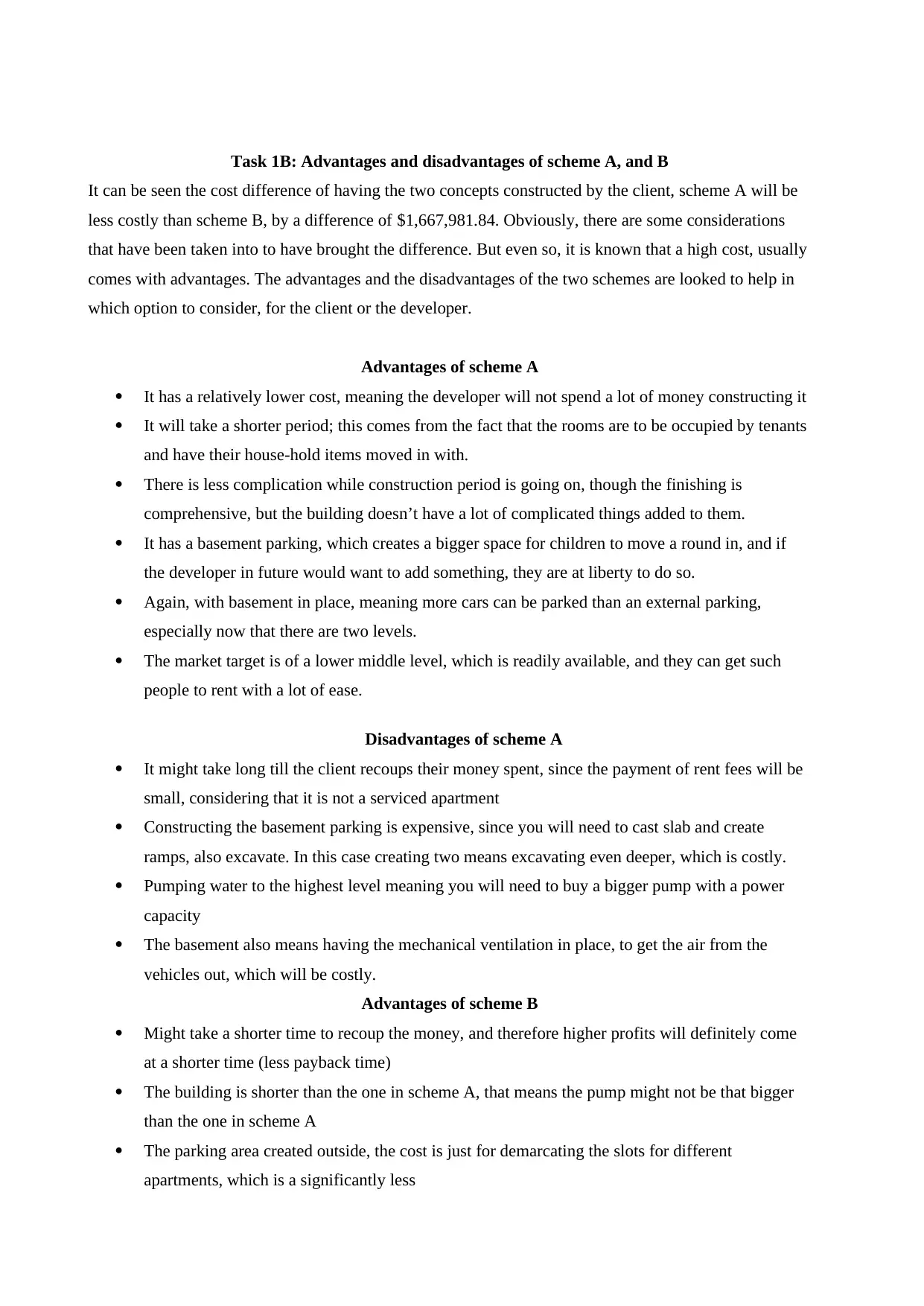
Task 1B: Advantages and disadvantages of scheme A, and B
It can be seen the cost difference of having the two concepts constructed by the client, scheme A will be
less costly than scheme B, by a difference of $1,667,981.84. Obviously, there are some considerations
that have been taken into to have brought the difference. But even so, it is known that a high cost, usually
comes with advantages. The advantages and the disadvantages of the two schemes are looked to help in
which option to consider, for the client or the developer.
Advantages of scheme A
It has a relatively lower cost, meaning the developer will not spend a lot of money constructing it
It will take a shorter period; this comes from the fact that the rooms are to be occupied by tenants
and have their house-hold items moved in with.
There is less complication while construction period is going on, though the finishing is
comprehensive, but the building doesn’t have a lot of complicated things added to them.
It has a basement parking, which creates a bigger space for children to move a round in, and if
the developer in future would want to add something, they are at liberty to do so.
Again, with basement in place, meaning more cars can be parked than an external parking,
especially now that there are two levels.
The market target is of a lower middle level, which is readily available, and they can get such
people to rent with a lot of ease.
Disadvantages of scheme A
It might take long till the client recoups their money spent, since the payment of rent fees will be
small, considering that it is not a serviced apartment
Constructing the basement parking is expensive, since you will need to cast slab and create
ramps, also excavate. In this case creating two means excavating even deeper, which is costly.
Pumping water to the highest level meaning you will need to buy a bigger pump with a power
capacity
The basement also means having the mechanical ventilation in place, to get the air from the
vehicles out, which will be costly.
Advantages of scheme B
Might take a shorter time to recoup the money, and therefore higher profits will definitely come
at a shorter time (less payback time)
The building is shorter than the one in scheme A, that means the pump might not be that bigger
than the one in scheme A
The parking area created outside, the cost is just for demarcating the slots for different
apartments, which is a significantly less
It can be seen the cost difference of having the two concepts constructed by the client, scheme A will be
less costly than scheme B, by a difference of $1,667,981.84. Obviously, there are some considerations
that have been taken into to have brought the difference. But even so, it is known that a high cost, usually
comes with advantages. The advantages and the disadvantages of the two schemes are looked to help in
which option to consider, for the client or the developer.
Advantages of scheme A
It has a relatively lower cost, meaning the developer will not spend a lot of money constructing it
It will take a shorter period; this comes from the fact that the rooms are to be occupied by tenants
and have their house-hold items moved in with.
There is less complication while construction period is going on, though the finishing is
comprehensive, but the building doesn’t have a lot of complicated things added to them.
It has a basement parking, which creates a bigger space for children to move a round in, and if
the developer in future would want to add something, they are at liberty to do so.
Again, with basement in place, meaning more cars can be parked than an external parking,
especially now that there are two levels.
The market target is of a lower middle level, which is readily available, and they can get such
people to rent with a lot of ease.
Disadvantages of scheme A
It might take long till the client recoups their money spent, since the payment of rent fees will be
small, considering that it is not a serviced apartment
Constructing the basement parking is expensive, since you will need to cast slab and create
ramps, also excavate. In this case creating two means excavating even deeper, which is costly.
Pumping water to the highest level meaning you will need to buy a bigger pump with a power
capacity
The basement also means having the mechanical ventilation in place, to get the air from the
vehicles out, which will be costly.
Advantages of scheme B
Might take a shorter time to recoup the money, and therefore higher profits will definitely come
at a shorter time (less payback time)
The building is shorter than the one in scheme A, that means the pump might not be that bigger
than the one in scheme A
The parking area created outside, the cost is just for demarcating the slots for different
apartments, which is a significantly less
Secure Best Marks with AI Grader
Need help grading? Try our AI Grader for instant feedback on your assignments.
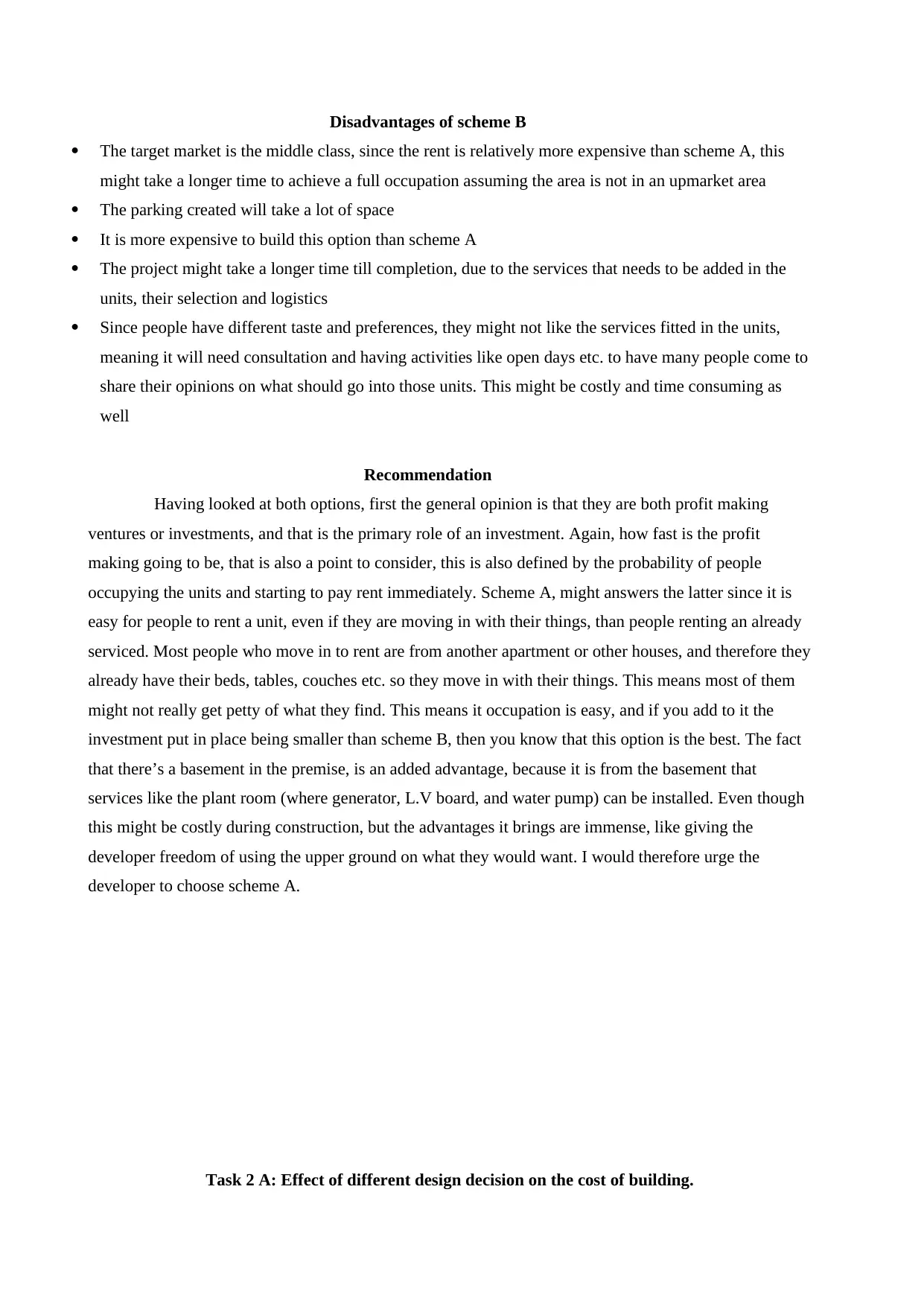
Disadvantages of scheme B
The target market is the middle class, since the rent is relatively more expensive than scheme A, this
might take a longer time to achieve a full occupation assuming the area is not in an upmarket area
The parking created will take a lot of space
It is more expensive to build this option than scheme A
The project might take a longer time till completion, due to the services that needs to be added in the
units, their selection and logistics
Since people have different taste and preferences, they might not like the services fitted in the units,
meaning it will need consultation and having activities like open days etc. to have many people come to
share their opinions on what should go into those units. This might be costly and time consuming as
well
Recommendation
Having looked at both options, first the general opinion is that they are both profit making
ventures or investments, and that is the primary role of an investment. Again, how fast is the profit
making going to be, that is also a point to consider, this is also defined by the probability of people
occupying the units and starting to pay rent immediately. Scheme A, might answers the latter since it is
easy for people to rent a unit, even if they are moving in with their things, than people renting an already
serviced. Most people who move in to rent are from another apartment or other houses, and therefore they
already have their beds, tables, couches etc. so they move in with their things. This means most of them
might not really get petty of what they find. This means it occupation is easy, and if you add to it the
investment put in place being smaller than scheme B, then you know that this option is the best. The fact
that there’s a basement in the premise, is an added advantage, because it is from the basement that
services like the plant room (where generator, L.V board, and water pump) can be installed. Even though
this might be costly during construction, but the advantages it brings are immense, like giving the
developer freedom of using the upper ground on what they would want. I would therefore urge the
developer to choose scheme A.
Task 2 A: Effect of different design decision on the cost of building.
The target market is the middle class, since the rent is relatively more expensive than scheme A, this
might take a longer time to achieve a full occupation assuming the area is not in an upmarket area
The parking created will take a lot of space
It is more expensive to build this option than scheme A
The project might take a longer time till completion, due to the services that needs to be added in the
units, their selection and logistics
Since people have different taste and preferences, they might not like the services fitted in the units,
meaning it will need consultation and having activities like open days etc. to have many people come to
share their opinions on what should go into those units. This might be costly and time consuming as
well
Recommendation
Having looked at both options, first the general opinion is that they are both profit making
ventures or investments, and that is the primary role of an investment. Again, how fast is the profit
making going to be, that is also a point to consider, this is also defined by the probability of people
occupying the units and starting to pay rent immediately. Scheme A, might answers the latter since it is
easy for people to rent a unit, even if they are moving in with their things, than people renting an already
serviced. Most people who move in to rent are from another apartment or other houses, and therefore they
already have their beds, tables, couches etc. so they move in with their things. This means most of them
might not really get petty of what they find. This means it occupation is easy, and if you add to it the
investment put in place being smaller than scheme B, then you know that this option is the best. The fact
that there’s a basement in the premise, is an added advantage, because it is from the basement that
services like the plant room (where generator, L.V board, and water pump) can be installed. Even though
this might be costly during construction, but the advantages it brings are immense, like giving the
developer freedom of using the upper ground on what they would want. I would therefore urge the
developer to choose scheme A.
Task 2 A: Effect of different design decision on the cost of building.
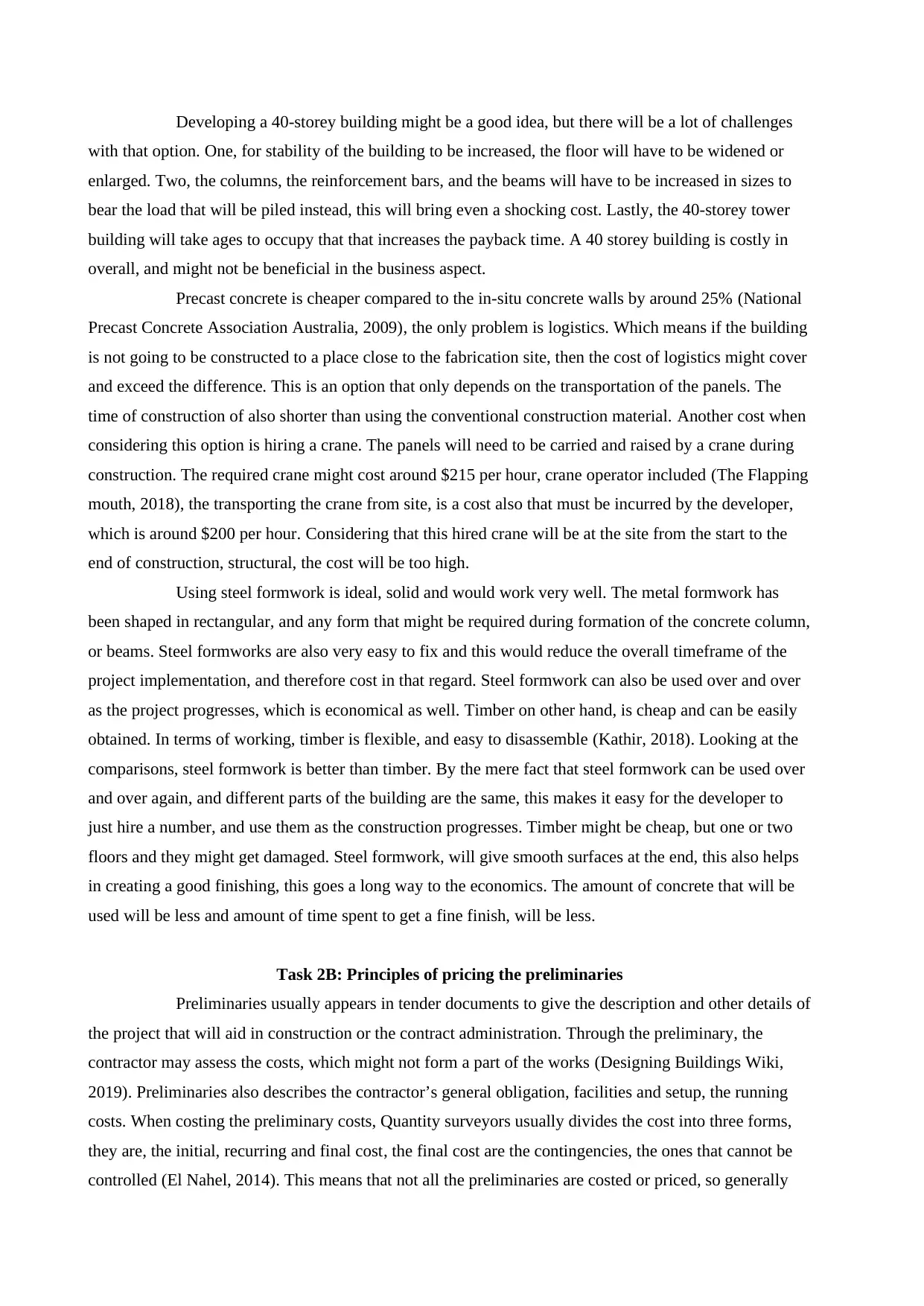
Developing a 40-storey building might be a good idea, but there will be a lot of challenges
with that option. One, for stability of the building to be increased, the floor will have to be widened or
enlarged. Two, the columns, the reinforcement bars, and the beams will have to be increased in sizes to
bear the load that will be piled instead, this will bring even a shocking cost. Lastly, the 40-storey tower
building will take ages to occupy that that increases the payback time. A 40 storey building is costly in
overall, and might not be beneficial in the business aspect.
Precast concrete is cheaper compared to the in-situ concrete walls by around 25% (National
Precast Concrete Association Australia, 2009), the only problem is logistics. Which means if the building
is not going to be constructed to a place close to the fabrication site, then the cost of logistics might cover
and exceed the difference. This is an option that only depends on the transportation of the panels. The
time of construction of also shorter than using the conventional construction material. Another cost when
considering this option is hiring a crane. The panels will need to be carried and raised by a crane during
construction. The required crane might cost around $215 per hour, crane operator included (The Flapping
mouth, 2018), the transporting the crane from site, is a cost also that must be incurred by the developer,
which is around $200 per hour. Considering that this hired crane will be at the site from the start to the
end of construction, structural, the cost will be too high.
Using steel formwork is ideal, solid and would work very well. The metal formwork has
been shaped in rectangular, and any form that might be required during formation of the concrete column,
or beams. Steel formworks are also very easy to fix and this would reduce the overall timeframe of the
project implementation, and therefore cost in that regard. Steel formwork can also be used over and over
as the project progresses, which is economical as well. Timber on other hand, is cheap and can be easily
obtained. In terms of working, timber is flexible, and easy to disassemble (Kathir, 2018). Looking at the
comparisons, steel formwork is better than timber. By the mere fact that steel formwork can be used over
and over again, and different parts of the building are the same, this makes it easy for the developer to
just hire a number, and use them as the construction progresses. Timber might be cheap, but one or two
floors and they might get damaged. Steel formwork, will give smooth surfaces at the end, this also helps
in creating a good finishing, this goes a long way to the economics. The amount of concrete that will be
used will be less and amount of time spent to get a fine finish, will be less.
Task 2B: Principles of pricing the preliminaries
Preliminaries usually appears in tender documents to give the description and other details of
the project that will aid in construction or the contract administration. Through the preliminary, the
contractor may assess the costs, which might not form a part of the works (Designing Buildings Wiki,
2019). Preliminaries also describes the contractor’s general obligation, facilities and setup, the running
costs. When costing the preliminary costs, Quantity surveyors usually divides the cost into three forms,
they are, the initial, recurring and final cost, the final cost are the contingencies, the ones that cannot be
controlled (El Nahel, 2014). This means that not all the preliminaries are costed or priced, so generally
with that option. One, for stability of the building to be increased, the floor will have to be widened or
enlarged. Two, the columns, the reinforcement bars, and the beams will have to be increased in sizes to
bear the load that will be piled instead, this will bring even a shocking cost. Lastly, the 40-storey tower
building will take ages to occupy that that increases the payback time. A 40 storey building is costly in
overall, and might not be beneficial in the business aspect.
Precast concrete is cheaper compared to the in-situ concrete walls by around 25% (National
Precast Concrete Association Australia, 2009), the only problem is logistics. Which means if the building
is not going to be constructed to a place close to the fabrication site, then the cost of logistics might cover
and exceed the difference. This is an option that only depends on the transportation of the panels. The
time of construction of also shorter than using the conventional construction material. Another cost when
considering this option is hiring a crane. The panels will need to be carried and raised by a crane during
construction. The required crane might cost around $215 per hour, crane operator included (The Flapping
mouth, 2018), the transporting the crane from site, is a cost also that must be incurred by the developer,
which is around $200 per hour. Considering that this hired crane will be at the site from the start to the
end of construction, structural, the cost will be too high.
Using steel formwork is ideal, solid and would work very well. The metal formwork has
been shaped in rectangular, and any form that might be required during formation of the concrete column,
or beams. Steel formworks are also very easy to fix and this would reduce the overall timeframe of the
project implementation, and therefore cost in that regard. Steel formwork can also be used over and over
as the project progresses, which is economical as well. Timber on other hand, is cheap and can be easily
obtained. In terms of working, timber is flexible, and easy to disassemble (Kathir, 2018). Looking at the
comparisons, steel formwork is better than timber. By the mere fact that steel formwork can be used over
and over again, and different parts of the building are the same, this makes it easy for the developer to
just hire a number, and use them as the construction progresses. Timber might be cheap, but one or two
floors and they might get damaged. Steel formwork, will give smooth surfaces at the end, this also helps
in creating a good finishing, this goes a long way to the economics. The amount of concrete that will be
used will be less and amount of time spent to get a fine finish, will be less.
Task 2B: Principles of pricing the preliminaries
Preliminaries usually appears in tender documents to give the description and other details of
the project that will aid in construction or the contract administration. Through the preliminary, the
contractor may assess the costs, which might not form a part of the works (Designing Buildings Wiki,
2019). Preliminaries also describes the contractor’s general obligation, facilities and setup, the running
costs. When costing the preliminary costs, Quantity surveyors usually divides the cost into three forms,
they are, the initial, recurring and final cost, the final cost are the contingencies, the ones that cannot be
controlled (El Nahel, 2014). This means that not all the preliminaries are costed or priced, so generally
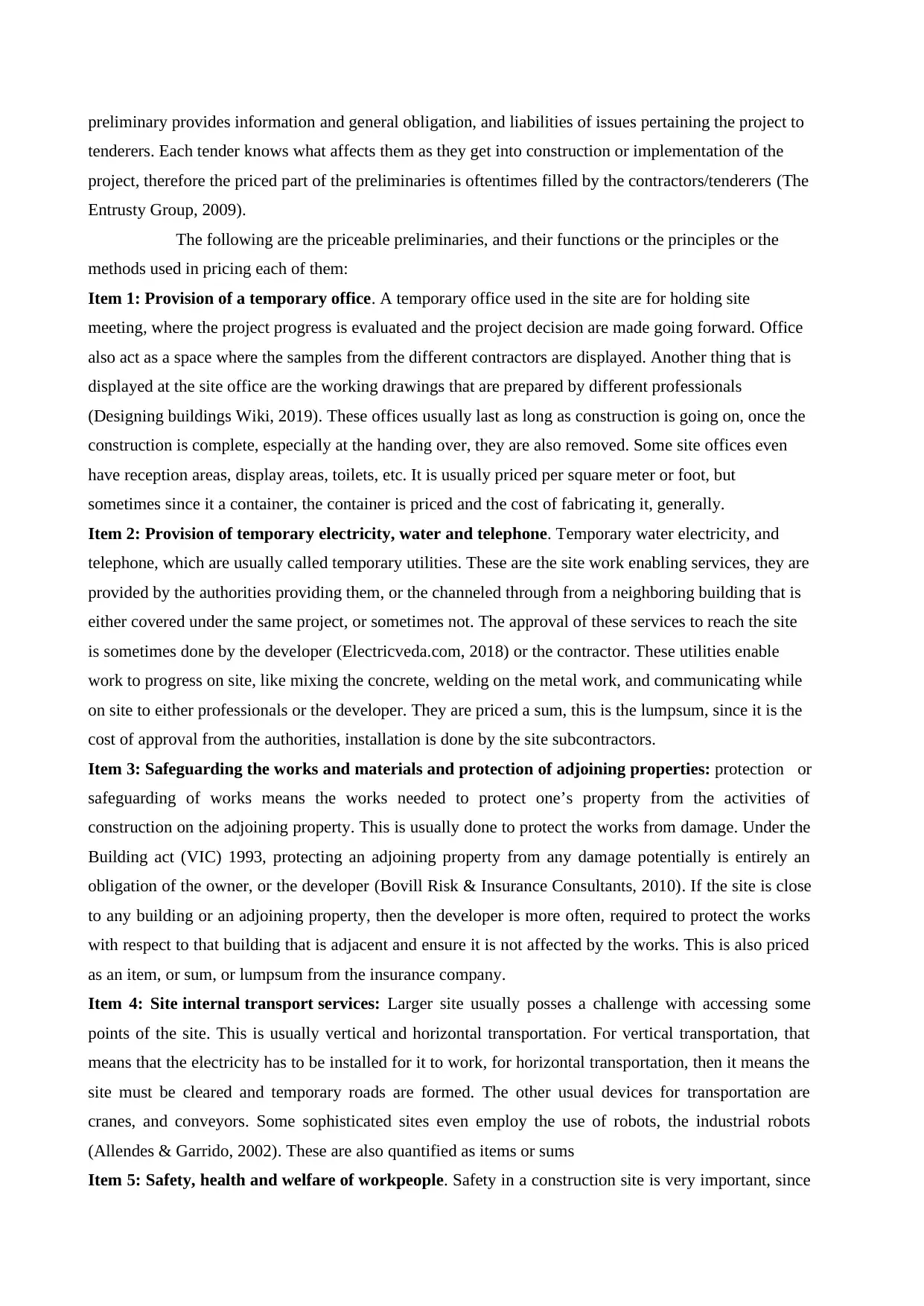
preliminary provides information and general obligation, and liabilities of issues pertaining the project to
tenderers. Each tender knows what affects them as they get into construction or implementation of the
project, therefore the priced part of the preliminaries is oftentimes filled by the contractors/tenderers (The
Entrusty Group, 2009).
The following are the priceable preliminaries, and their functions or the principles or the
methods used in pricing each of them:
Item 1: Provision of a temporary office. A temporary office used in the site are for holding site
meeting, where the project progress is evaluated and the project decision are made going forward. Office
also act as a space where the samples from the different contractors are displayed. Another thing that is
displayed at the site office are the working drawings that are prepared by different professionals
(Designing buildings Wiki, 2019). These offices usually last as long as construction is going on, once the
construction is complete, especially at the handing over, they are also removed. Some site offices even
have reception areas, display areas, toilets, etc. It is usually priced per square meter or foot, but
sometimes since it a container, the container is priced and the cost of fabricating it, generally.
Item 2: Provision of temporary electricity, water and telephone. Temporary water electricity, and
telephone, which are usually called temporary utilities. These are the site work enabling services, they are
provided by the authorities providing them, or the channeled through from a neighboring building that is
either covered under the same project, or sometimes not. The approval of these services to reach the site
is sometimes done by the developer (Electricveda.com, 2018) or the contractor. These utilities enable
work to progress on site, like mixing the concrete, welding on the metal work, and communicating while
on site to either professionals or the developer. They are priced a sum, this is the lumpsum, since it is the
cost of approval from the authorities, installation is done by the site subcontractors.
Item 3: Safeguarding the works and materials and protection of adjoining properties: protection or
safeguarding of works means the works needed to protect one’s property from the activities of
construction on the adjoining property. This is usually done to protect the works from damage. Under the
Building act (VIC) 1993, protecting an adjoining property from any damage potentially is entirely an
obligation of the owner, or the developer (Bovill Risk & Insurance Consultants, 2010). If the site is close
to any building or an adjoining property, then the developer is more often, required to protect the works
with respect to that building that is adjacent and ensure it is not affected by the works. This is also priced
as an item, or sum, or lumpsum from the insurance company.
Item 4: Site internal transport services: Larger site usually posses a challenge with accessing some
points of the site. This is usually vertical and horizontal transportation. For vertical transportation, that
means that the electricity has to be installed for it to work, for horizontal transportation, then it means the
site must be cleared and temporary roads are formed. The other usual devices for transportation are
cranes, and conveyors. Some sophisticated sites even employ the use of robots, the industrial robots
(Allendes & Garrido, 2002). These are also quantified as items or sums
Item 5: Safety, health and welfare of workpeople. Safety in a construction site is very important, since
tenderers. Each tender knows what affects them as they get into construction or implementation of the
project, therefore the priced part of the preliminaries is oftentimes filled by the contractors/tenderers (The
Entrusty Group, 2009).
The following are the priceable preliminaries, and their functions or the principles or the
methods used in pricing each of them:
Item 1: Provision of a temporary office. A temporary office used in the site are for holding site
meeting, where the project progress is evaluated and the project decision are made going forward. Office
also act as a space where the samples from the different contractors are displayed. Another thing that is
displayed at the site office are the working drawings that are prepared by different professionals
(Designing buildings Wiki, 2019). These offices usually last as long as construction is going on, once the
construction is complete, especially at the handing over, they are also removed. Some site offices even
have reception areas, display areas, toilets, etc. It is usually priced per square meter or foot, but
sometimes since it a container, the container is priced and the cost of fabricating it, generally.
Item 2: Provision of temporary electricity, water and telephone. Temporary water electricity, and
telephone, which are usually called temporary utilities. These are the site work enabling services, they are
provided by the authorities providing them, or the channeled through from a neighboring building that is
either covered under the same project, or sometimes not. The approval of these services to reach the site
is sometimes done by the developer (Electricveda.com, 2018) or the contractor. These utilities enable
work to progress on site, like mixing the concrete, welding on the metal work, and communicating while
on site to either professionals or the developer. They are priced a sum, this is the lumpsum, since it is the
cost of approval from the authorities, installation is done by the site subcontractors.
Item 3: Safeguarding the works and materials and protection of adjoining properties: protection or
safeguarding of works means the works needed to protect one’s property from the activities of
construction on the adjoining property. This is usually done to protect the works from damage. Under the
Building act (VIC) 1993, protecting an adjoining property from any damage potentially is entirely an
obligation of the owner, or the developer (Bovill Risk & Insurance Consultants, 2010). If the site is close
to any building or an adjoining property, then the developer is more often, required to protect the works
with respect to that building that is adjacent and ensure it is not affected by the works. This is also priced
as an item, or sum, or lumpsum from the insurance company.
Item 4: Site internal transport services: Larger site usually posses a challenge with accessing some
points of the site. This is usually vertical and horizontal transportation. For vertical transportation, that
means that the electricity has to be installed for it to work, for horizontal transportation, then it means the
site must be cleared and temporary roads are formed. The other usual devices for transportation are
cranes, and conveyors. Some sophisticated sites even employ the use of robots, the industrial robots
(Allendes & Garrido, 2002). These are also quantified as items or sums
Item 5: Safety, health and welfare of workpeople. Safety in a construction site is very important, since
Paraphrase This Document
Need a fresh take? Get an instant paraphrase of this document with our AI Paraphraser
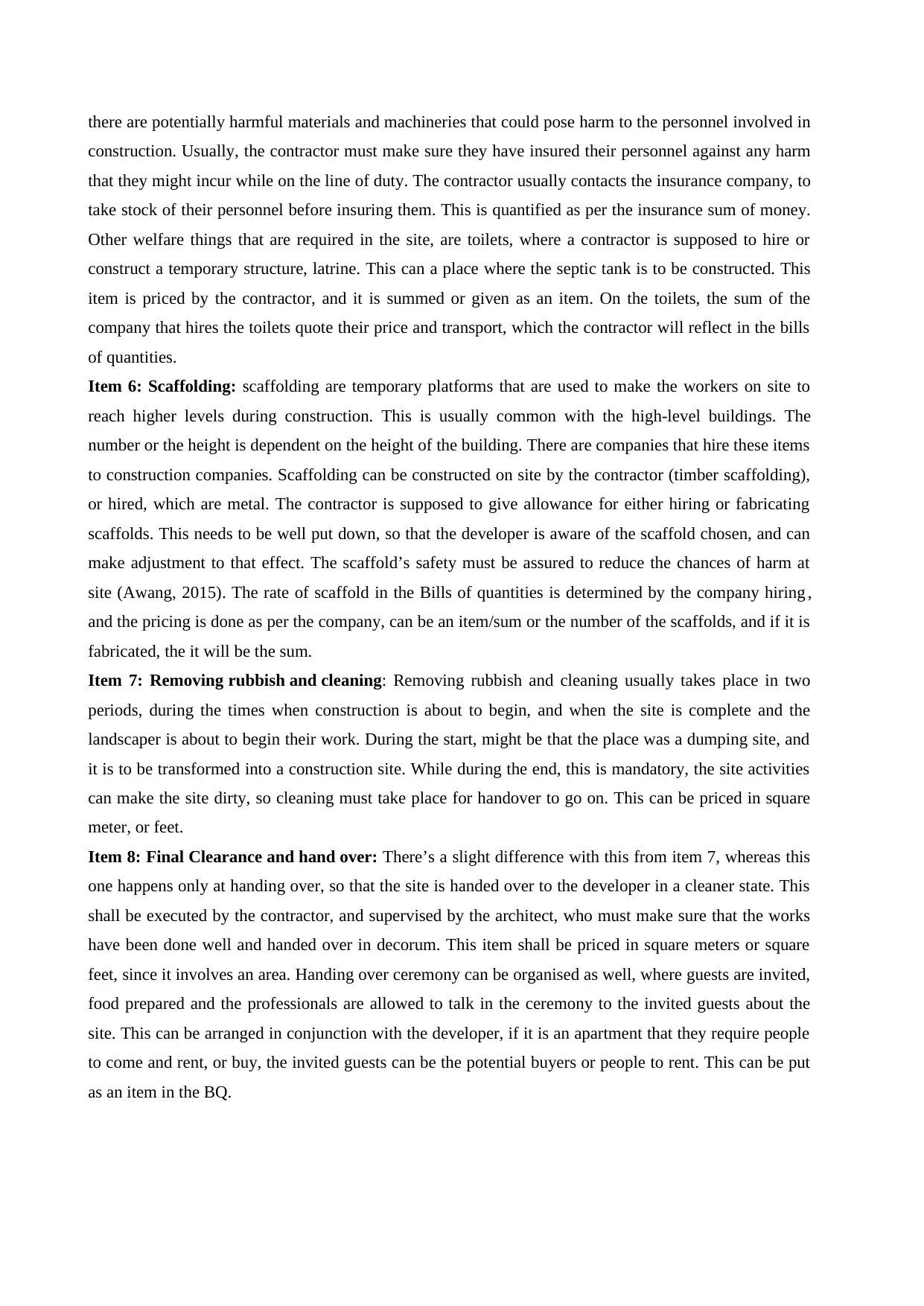
there are potentially harmful materials and machineries that could pose harm to the personnel involved in
construction. Usually, the contractor must make sure they have insured their personnel against any harm
that they might incur while on the line of duty. The contractor usually contacts the insurance company, to
take stock of their personnel before insuring them. This is quantified as per the insurance sum of money.
Other welfare things that are required in the site, are toilets, where a contractor is supposed to hire or
construct a temporary structure, latrine. This can a place where the septic tank is to be constructed. This
item is priced by the contractor, and it is summed or given as an item. On the toilets, the sum of the
company that hires the toilets quote their price and transport, which the contractor will reflect in the bills
of quantities.
Item 6: Scaffolding: scaffolding are temporary platforms that are used to make the workers on site to
reach higher levels during construction. This is usually common with the high-level buildings. The
number or the height is dependent on the height of the building. There are companies that hire these items
to construction companies. Scaffolding can be constructed on site by the contractor (timber scaffolding),
or hired, which are metal. The contractor is supposed to give allowance for either hiring or fabricating
scaffolds. This needs to be well put down, so that the developer is aware of the scaffold chosen, and can
make adjustment to that effect. The scaffold’s safety must be assured to reduce the chances of harm at
site (Awang, 2015). The rate of scaffold in the Bills of quantities is determined by the company hiring ,
and the pricing is done as per the company, can be an item/sum or the number of the scaffolds, and if it is
fabricated, the it will be the sum.
Item 7: Removing rubbish and cleaning: Removing rubbish and cleaning usually takes place in two
periods, during the times when construction is about to begin, and when the site is complete and the
landscaper is about to begin their work. During the start, might be that the place was a dumping site, and
it is to be transformed into a construction site. While during the end, this is mandatory, the site activities
can make the site dirty, so cleaning must take place for handover to go on. This can be priced in square
meter, or feet.
Item 8: Final Clearance and hand over: There’s a slight difference with this from item 7, whereas this
one happens only at handing over, so that the site is handed over to the developer in a cleaner state. This
shall be executed by the contractor, and supervised by the architect, who must make sure that the works
have been done well and handed over in decorum. This item shall be priced in square meters or square
feet, since it involves an area. Handing over ceremony can be organised as well, where guests are invited,
food prepared and the professionals are allowed to talk in the ceremony to the invited guests about the
site. This can be arranged in conjunction with the developer, if it is an apartment that they require people
to come and rent, or buy, the invited guests can be the potential buyers or people to rent. This can be put
as an item in the BQ.
construction. Usually, the contractor must make sure they have insured their personnel against any harm
that they might incur while on the line of duty. The contractor usually contacts the insurance company, to
take stock of their personnel before insuring them. This is quantified as per the insurance sum of money.
Other welfare things that are required in the site, are toilets, where a contractor is supposed to hire or
construct a temporary structure, latrine. This can a place where the septic tank is to be constructed. This
item is priced by the contractor, and it is summed or given as an item. On the toilets, the sum of the
company that hires the toilets quote their price and transport, which the contractor will reflect in the bills
of quantities.
Item 6: Scaffolding: scaffolding are temporary platforms that are used to make the workers on site to
reach higher levels during construction. This is usually common with the high-level buildings. The
number or the height is dependent on the height of the building. There are companies that hire these items
to construction companies. Scaffolding can be constructed on site by the contractor (timber scaffolding),
or hired, which are metal. The contractor is supposed to give allowance for either hiring or fabricating
scaffolds. This needs to be well put down, so that the developer is aware of the scaffold chosen, and can
make adjustment to that effect. The scaffold’s safety must be assured to reduce the chances of harm at
site (Awang, 2015). The rate of scaffold in the Bills of quantities is determined by the company hiring ,
and the pricing is done as per the company, can be an item/sum or the number of the scaffolds, and if it is
fabricated, the it will be the sum.
Item 7: Removing rubbish and cleaning: Removing rubbish and cleaning usually takes place in two
periods, during the times when construction is about to begin, and when the site is complete and the
landscaper is about to begin their work. During the start, might be that the place was a dumping site, and
it is to be transformed into a construction site. While during the end, this is mandatory, the site activities
can make the site dirty, so cleaning must take place for handover to go on. This can be priced in square
meter, or feet.
Item 8: Final Clearance and hand over: There’s a slight difference with this from item 7, whereas this
one happens only at handing over, so that the site is handed over to the developer in a cleaner state. This
shall be executed by the contractor, and supervised by the architect, who must make sure that the works
have been done well and handed over in decorum. This item shall be priced in square meters or square
feet, since it involves an area. Handing over ceremony can be organised as well, where guests are invited,
food prepared and the professionals are allowed to talk in the ceremony to the invited guests about the
site. This can be arranged in conjunction with the developer, if it is an apartment that they require people
to come and rent, or buy, the invited guests can be the potential buyers or people to rent. This can be put
as an item in the BQ.
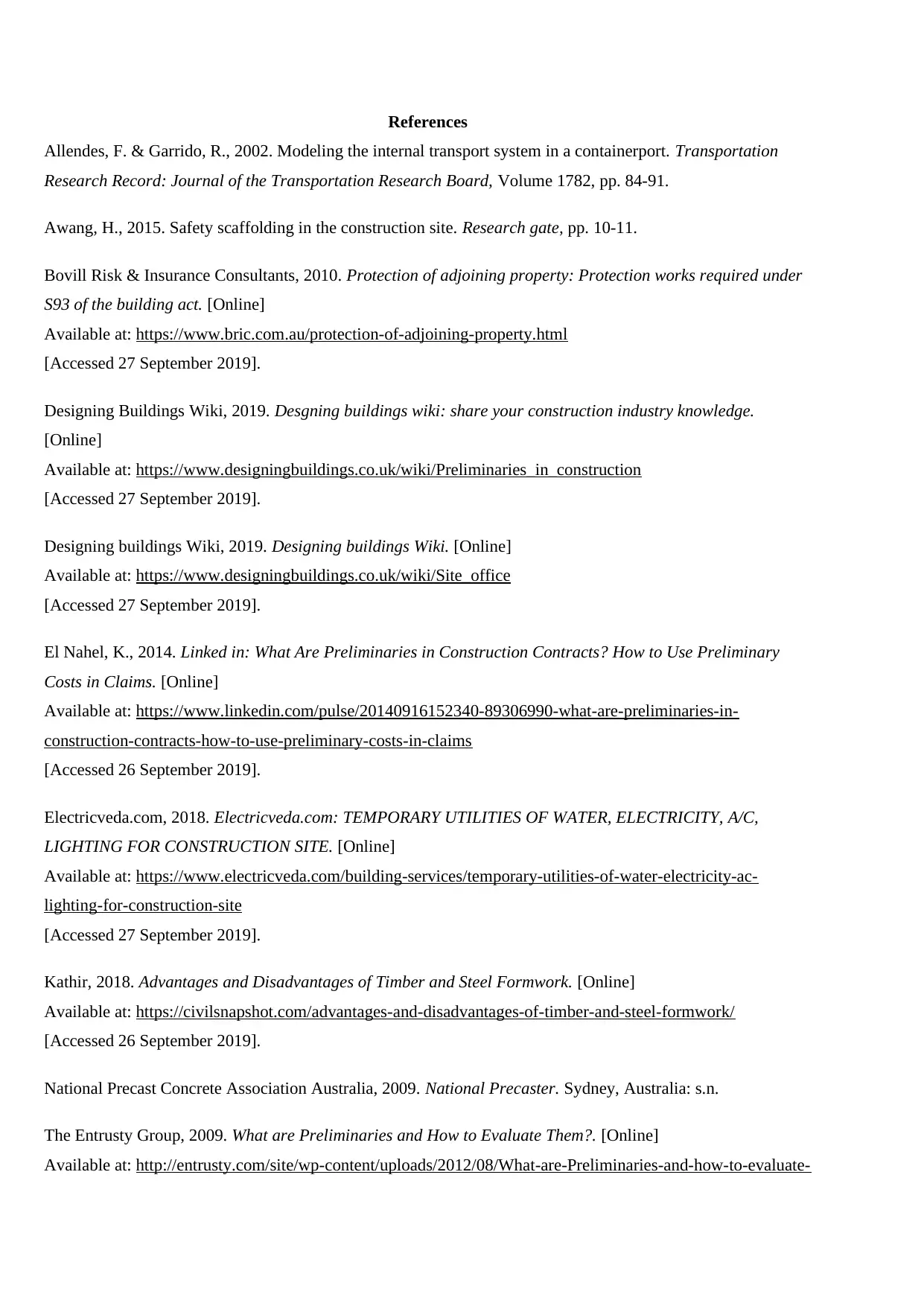
References
Allendes, F. & Garrido, R., 2002. Modeling the internal transport system in a containerport. Transportation
Research Record: Journal of the Transportation Research Board, Volume 1782, pp. 84-91.
Awang, H., 2015. Safety scaffolding in the construction site. Research gate, pp. 10-11.
Bovill Risk & Insurance Consultants, 2010. Protection of adjoining property: Protection works required under
S93 of the building act. [Online]
Available at: https://www.bric.com.au/protection-of-adjoining-property.html
[Accessed 27 September 2019].
Designing Buildings Wiki, 2019. Desgning buildings wiki: share your construction industry knowledge.
[Online]
Available at: https://www.designingbuildings.co.uk/wiki/Preliminaries_in_construction
[Accessed 27 September 2019].
Designing buildings Wiki, 2019. Designing buildings Wiki. [Online]
Available at: https://www.designingbuildings.co.uk/wiki/Site_office
[Accessed 27 September 2019].
El Nahel, K., 2014. Linked in: What Are Preliminaries in Construction Contracts? How to Use Preliminary
Costs in Claims. [Online]
Available at: https://www.linkedin.com/pulse/20140916152340-89306990-what-are-preliminaries-in-
construction-contracts-how-to-use-preliminary-costs-in-claims
[Accessed 26 September 2019].
Electricveda.com, 2018. Electricveda.com: TEMPORARY UTILITIES OF WATER, ELECTRICITY, A/C,
LIGHTING FOR CONSTRUCTION SITE. [Online]
Available at: https://www.electricveda.com/building-services/temporary-utilities-of-water-electricity-ac-
lighting-for-construction-site
[Accessed 27 September 2019].
Kathir, 2018. Advantages and Disadvantages of Timber and Steel Formwork. [Online]
Available at: https://civilsnapshot.com/advantages-and-disadvantages-of-timber-and-steel-formwork/
[Accessed 26 September 2019].
National Precast Concrete Association Australia, 2009. National Precaster. Sydney, Australia: s.n.
The Entrusty Group, 2009. What are Preliminaries and How to Evaluate Them?. [Online]
Available at: http://entrusty.com/site/wp-content/uploads/2012/08/What-are-Preliminaries-and-how-to-evaluate-
Allendes, F. & Garrido, R., 2002. Modeling the internal transport system in a containerport. Transportation
Research Record: Journal of the Transportation Research Board, Volume 1782, pp. 84-91.
Awang, H., 2015. Safety scaffolding in the construction site. Research gate, pp. 10-11.
Bovill Risk & Insurance Consultants, 2010. Protection of adjoining property: Protection works required under
S93 of the building act. [Online]
Available at: https://www.bric.com.au/protection-of-adjoining-property.html
[Accessed 27 September 2019].
Designing Buildings Wiki, 2019. Desgning buildings wiki: share your construction industry knowledge.
[Online]
Available at: https://www.designingbuildings.co.uk/wiki/Preliminaries_in_construction
[Accessed 27 September 2019].
Designing buildings Wiki, 2019. Designing buildings Wiki. [Online]
Available at: https://www.designingbuildings.co.uk/wiki/Site_office
[Accessed 27 September 2019].
El Nahel, K., 2014. Linked in: What Are Preliminaries in Construction Contracts? How to Use Preliminary
Costs in Claims. [Online]
Available at: https://www.linkedin.com/pulse/20140916152340-89306990-what-are-preliminaries-in-
construction-contracts-how-to-use-preliminary-costs-in-claims
[Accessed 26 September 2019].
Electricveda.com, 2018. Electricveda.com: TEMPORARY UTILITIES OF WATER, ELECTRICITY, A/C,
LIGHTING FOR CONSTRUCTION SITE. [Online]
Available at: https://www.electricveda.com/building-services/temporary-utilities-of-water-electricity-ac-
lighting-for-construction-site
[Accessed 27 September 2019].
Kathir, 2018. Advantages and Disadvantages of Timber and Steel Formwork. [Online]
Available at: https://civilsnapshot.com/advantages-and-disadvantages-of-timber-and-steel-formwork/
[Accessed 26 September 2019].
National Precast Concrete Association Australia, 2009. National Precaster. Sydney, Australia: s.n.
The Entrusty Group, 2009. What are Preliminaries and How to Evaluate Them?. [Online]
Available at: http://entrusty.com/site/wp-content/uploads/2012/08/What-are-Preliminaries-and-how-to-evaluate-

them.pdf
[Accessed 27 September 2019].
The Flapping mouth, 2018. ISEEKPLANT. [Online]
Available at: https://blog.iseekplant.com.au/blog/crane-hire-rates-guide
[Accessed 26th September 2019].
[Accessed 27 September 2019].
The Flapping mouth, 2018. ISEEKPLANT. [Online]
Available at: https://blog.iseekplant.com.au/blog/crane-hire-rates-guide
[Accessed 26th September 2019].
1 out of 10
Your All-in-One AI-Powered Toolkit for Academic Success.
+13062052269
info@desklib.com
Available 24*7 on WhatsApp / Email
![[object Object]](/_next/static/media/star-bottom.7253800d.svg)
Unlock your academic potential
© 2024 | Zucol Services PVT LTD | All rights reserved.